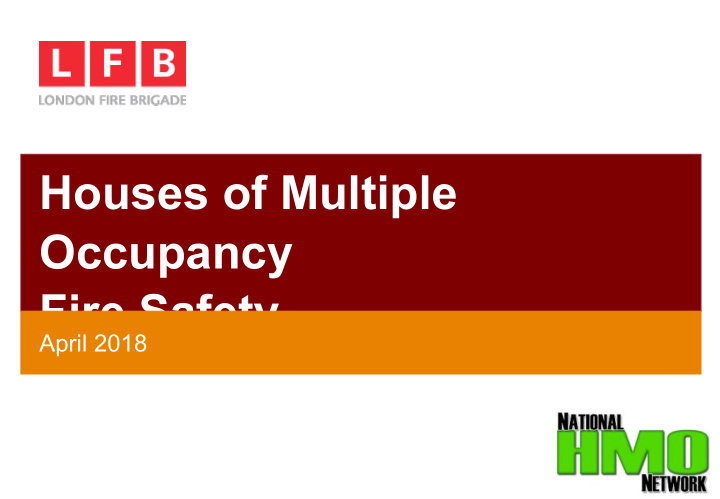



Houses of Multiple Occupancy Fire Safety April 2018
Key Messages Can we work in partnership? How can we assist each other? Are shared houses with vulnerable people HMO’s? Firefighter safety?
Introduction • The Fire Safety Order (FSO) applies to communal corridors and staircases of HMO’s, blocks of flats or Maisonettes • All the London Boroughs have signed the Housing Protocol on joint working arrangements with the LFB to improve fire safety within housing. We aim to: • Ensure that appropriate standards of fire safety and other safety provisions are provided and maintained. • Assist landlords and other providers to understand the legal framework under which they operate. • Encourage opportunities for offering joint training and awareness sessions for both authorities. • Encourage data sharing arrangements
Challenges of change to HMO licensing • The October 2018 Regulations could bring an extra 170,000 premises into the licensing regime in London, including flats in multiple occupation • LFB is a statutory consultee for HMO licensing – increases in workload for LA’s and LFB • Historically local authorities often call on LFB to take enforcement action even though we are not the lead authority. • HA’s can issue civil penalty notices up to a maximum of £30,000 - which is not an option available to LFB.
Challenges of change to HMO licensing • How do we identify a HMO? • Firefighters risk attending HMOs • Fire Safety Officers • What impact will the Smoke and Carbon Monoxide Alarm (England) Regulations have in its reissue? • Is the LACORs guidance still fit for purpose?
Key Risks – ignition sources (all dwelling types) Ignition Source 3 year Avg % Cooker 2,323 38% Kitchen appliances/white goods 813 13% Electrical distribution 732 12% Smoking related 567 9% Matches and Candles 378 6% Heating appliances 237 4% Lighting 175 3% Domestic appliances 75 1% Oth i iti 812 13%
Our commitment to vulnerable persons • Our proactive community engagement and fire safety inspections include ‘Person Centred Risk Assessments’. • Landlords should also ‘Spot the signs‘ - burns marks on clothes or furniture are often ignored. • Immediate action should be taken to reduce/remove risk. • Identified risks should be discussed with the person and be referred • LFB can conduct home fire safety visits.
What if a fire happens? • Know the plan! Is there a stay put policy in the building or are you advised to escape? • If a smoke alarm goes off do not assume it is a false alarm • Do not tackle the fire yourself • Before you open a door, check if it’s warm using the back of your hand • Keep calm and assist the resident out (but only if it is safe to do so) • Call 999 • Close doors behind you
Looking forward • Joint working with the HMO protocol review. • New Home Fire Safety initiatives. • Fire Safety Inspections will cover the structure and condition of the building, and also the arrangements for raising the alarm and evacuation. • Recording the risk for our firefighters, review our plans. • What about behind front doors?
Thank you
Recommend
More recommend